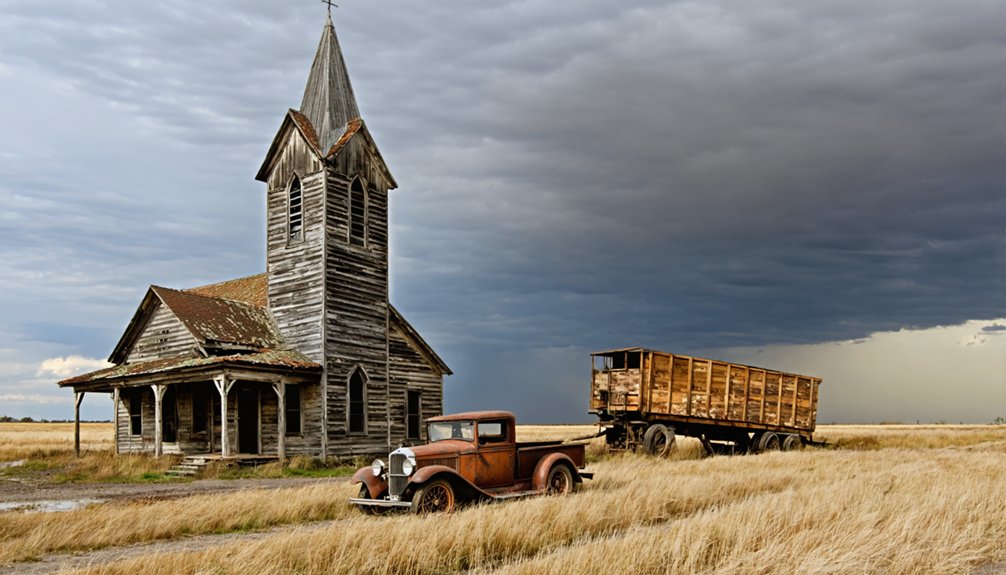You’ll find Coal Springs, a former mining settlement in South Dakota’s Firesteel region, established in 1907 when Andrew Traversie and William Benoist began commercial coal operations. The town flourished through the early 1900s with a post office, schools, and thriving community life centered around mining activities. While the settlement declined after 1954’s post office closure, you can still explore scattered foundations and mining remnants today, though the site’s remote location requires careful navigation and possibly a 4WD vehicle.
Key Takeaways
- Coal Springs was a mining community established in 1911, driven by the Firesteel coal deposits discovered and utilized since the 1880s.
- The town flourished during the early 1900s under Firesteel Coal Company, creating over 60 jobs and establishing essential community services.
- A post office operated from 1909 to 1954, serving as a vital communication hub before the town’s eventual decline.
- The community featured schools, churches, and social halls, with residents living in company-owned homes near mining operations.
- Today, only scattered foundations, collapsed wooden structures, and mining remnants mark the former settlement’s location.
The Birth of a Mining Community
While Native Americans had utilized the Firesteel coal deposits since the 1880s, commercial mining around Coal Springs didn’t begin until 1907, when Andrew Traversie and William Benoist started extracting coal for personal and limited commercial use.
Much like the sacred Black Hills, the area held deep cultural significance for local tribes before industrial development began.
Early prospectors approached cautiously, as the 1868 Treaty strictly protected Native American lands in the region.
The community origins truly took shape in 1911 when entrepreneurs Fred Hammersly and Charles Lindt launched larger operations, marking the start of Coal Springs’ transformation into a working mining town.
By 1923, the Firesteel Coal Company emerged as the area’s dominant force, creating over 60 jobs and expanding coal shipments across state lines into Iowa.
The town grew around these mining operations, with miner livelihoods dependent on the estimated 137,580,000 tons of coal in the Firesteel fields, establishing basic amenities and services to support the workers’ families.
Coal Springs’ Golden Era
Coal Springs reached its peak during the early 1900s when commercial mining operations employed sophisticated drilling and blasting techniques to extract coal from the rich Firesteel fields.
You’d have found a bustling community sustained by miners, engineers, and laborers who worked the underground and strip mines that produced coal for both local use and commercial sales.
The establishment of a post office in 1909 marked Coal Springs‘ status as a legitimate settlement, serving as a crucial communication hub for the mining community until 1954.
Similar to many ghost town sites in the Black Hills region, only scattered remnants of Coal Springs’ mining infrastructure remain visible today.
Safety was paramount in the mines, with workers required to wear protective gear including steel-toed shoes to prevent injuries while working in hazardous conditions.
Mining Operations Peak
During the early 1900s, mining operations in Coal Springs entered their golden era, beginning with Andrew Traversie and William Benoist’s initial coal extraction for personal use in 1907.
By 1911, Fred Hammersly and Charles Lindt established promising commercial mines in the area, tapping into the Firesteel coal fields‘ massive 137.58-million-ton potential.
Mining techniques evolved from underground operations to include strip mining when the South Dakota Relief Agency launched a state-owned venture in 1933. Workers utilized picks and shovels for basic extraction, similar to early gold mining methods in other parts of the state. The room and pillar method was commonly employed for deeper mineral deposits throughout South Dakota.
Despite economic fluctuations during the Great Depression, private miners maintained operations through the mid-20th century.
The district’s peak production supported local employment and industrial growth, though profitability never matched other states’ success.
The mines continued operating until 1969, when commercial operations finally ceased in the region.
Community Life Flourishes
As mining operations flourished in the early 1900s, a vibrant community took root in Coal Springs, transforming the frontier outpost into a close-knit settlement.
You’d find residents gathering regularly for community gatherings in multi-purpose buildings that served as schools, churches, and social halls. These spaces became the heart of Coal Springs’ cultural life, hosting seasonal celebrations that marked the passing of time and strengthened neighborly bonds.
Daily life centered around the mines, but you’d see a thriving network of general stores, supply shops, and essential services supporting the town’s families. Like many South Dakota towns positioned seven miles apart, Coal Springs developed along strategic railroad points to service steam locomotives.
Children attended the local schoolhouse, where dedicated teachers prepared them for life beyond the coal fields. Despite harsh conditions and isolation, residents adapted through mutual aid and resourcefulness, creating a resilient community that’d endure until economic changes led to its gradual decline.
Post Office Brings Prosperity
When the Coal Springs Post Office opened its doors in 1909, you’d witness the town’s transformation from a frontier settlement into a recognized community hub.
For 45 years, this essential institution served as the beating heart of local commerce and communication, enabling you to connect with the wider world through letters, packages, and newspapers.
The post office’s economic impact reached far beyond basic mail delivery. You’d find merchants ordering supplies, miners corresponding with labor offices, and entrepreneurs attracted to the town’s newfound legitimacy.
Through Rural Free Delivery routes, you could access catalogs and educational materials that bridged the gap between Coal Springs and urban centers.
The post office’s presence signaled government recognition, boosting community confidence and investment until its closure in 1954.
Life in Early 20th Century Coal Country
Life in early 20th century coal country revolved around the harsh realities of mining communities, where families endured difficult conditions while maintaining tight-knit social bonds.
You’d find men and boys spending long days underground, battling dangerous conditions and health challenges like black lung disease, while women managed households in company-owned homes. Their day started early, with morning bells signaling the start of their shifts.
Community dynamics centered on mutual support, with neighbors helping each other through shared hardships. Children as young as five or six would work alongside their fathers in the dangerous mines.
Mining families survived by leaning on one another, creating networks of support that made the unbearable somehow bearable.
The economic struggles were constant – you’d have to stretch meager wages while dealing with the company store system that often left families in debt.
Despite these challenges, strong cultural traditions emerged. You’d see women preserving food together, sharing traditional recipes, and fostering a resilient community spirit that helped families survive the tough mining life.
Economic Foundations and Development
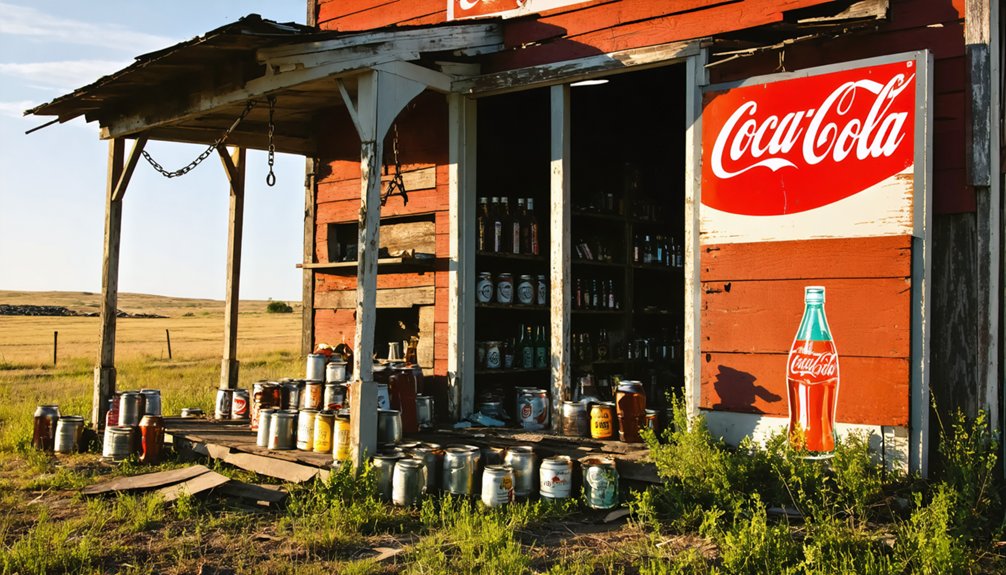
You’ll find Coal Springs’ remarkable economic growth directly tied to its mining operations, which attracted workers and businesses starting in 1908.
The establishment of a post office in 1909 marked Coal Springs’ emergence as a legitimate commercial hub, serving both the mining community and surrounding region.
The town’s mining-based economy peaked in the 1920s under the Firesteel Coal Company‘s operations, which employed over 60 workers and produced more than 40,000 tons of coal annually.
Mining Boom Drives Growth
The discovery of substantial coal deposits in the Firesteel fields transformed Coal Springs from a modest settlement into a thriving mining community in the early 1900s.
You’ll find that while Native Americans had used the coal since the 1880s, it wasn’t until Andrew Traversie and William Benoist began mining in 1907 that commercial potential emerged.
As mining techniques evolved from manual extraction to mechanized operations, the community’s resilience grew stronger.
Post Office Operations 1909-1954
Opening its doors in 1909, Coal Springs’ post office established essential communications infrastructure that would serve the mining community for forty-five years. As a significant community hub, it facilitated business correspondence, personal communications, and regional mail distribution throughout Perkins County.
You’ll find that postal services played a pivotal role in Coal Springs’ development:
- Connected miners and businesses to suppliers and markets beyond the region
- Provided employment through postmaster and carrier positions
- Established rural delivery routes serving surrounding homesteads
- Maintained official government presence until closure in 1954
The post office’s operations reflected the town’s economic trajectory – from the early mining boom through eventual decline.
When it closed its doors in 1954, it marked Coal Springs’ shift toward ghost town status.
From Boom to Bust: The Decline Years
During Coal Springs’ dramatic evolution from thriving mining hub to ghost town, several key factors converged to seal its fate.
You’ll find the decline stemmed primarily from the reduction in hard rock mining operations, which triggered widespread economic shifts throughout the Black Hills region. Similar to the fate of Mystic Reduction Mill, many processing facilities were demolished, marking the end of an era. As mines closed, infrastructure deteriorated and workers left, seeking opportunities elsewhere.
The town’s community resilience was further tested when railroad operations changed, dealing another blow to local commerce.
You can trace the town’s downward spiral through the closure of essential services and gradual exodus of residents. The younger generation moved to urban centers, leaving behind aging populations.
What remains today are weathered buildings, abandoned mine structures, and scattered tailings – silent reminders of Coal Springs’ once-prosperous past.
Post Office Legacy: 1909-1954
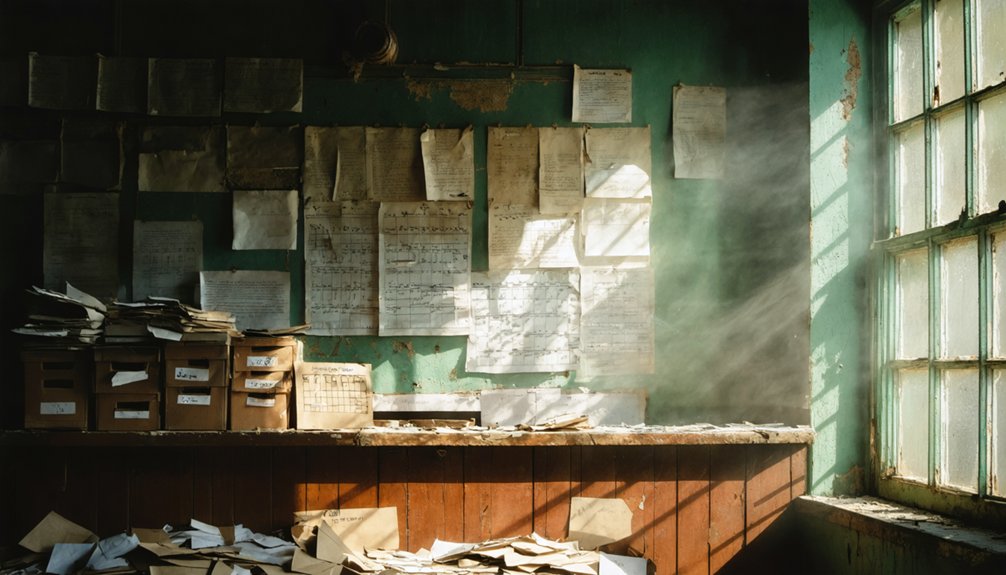
For 45 years, Coal Springs’ post office served as an essential communication hub connecting residents to the outside world from 1909 to 1954.
As part of the U.S. Postal Service’s rural route operations, it facilitated crucial correspondence for the mining community while documenting the town’s evolution.
You’ll find these fascinating aspects about Coal Springs’ post office communications:
- Carriers navigated carefully planned routes accounting for local topography and customer distribution.
- Post office records captured detailed site locations, patron numbers, and route changes.
- The facility handled everything from personal letters to mining industry dispatches.
- Rural route cards documented carrier details and establishment dates, preserving operational history.
The post office’s closure in 1954 marked the end of an era, coinciding with the town’s decline into ghost town status.
Structural Remnants and Historical Sites
While Coal Springs’ post office records chronicled the town’s life through paperwork, its physical remains tell an equally compelling story today.
During ghost town exploration, you’ll find scattered foundations and structural debris that hint at the community’s modest mining origins. The site features remnants of simple log cabins and mining facilities, though most wooden structures have collapsed over time.
You’ll discover evidence of the town’s mining heritage through eroded tailings piles, shaft house remains, and rusted cyanide vats.
While Coal Springs lacks the architectural significance of ornate stone buildings found in other Black Hills ghost towns, its utilitarian building footprints and scattered brick piles reveal the practical nature of this early 20th-century mining settlement.
Mining manager residences stand among the few better-preserved structures.
Mining Heritage and Cultural Impact
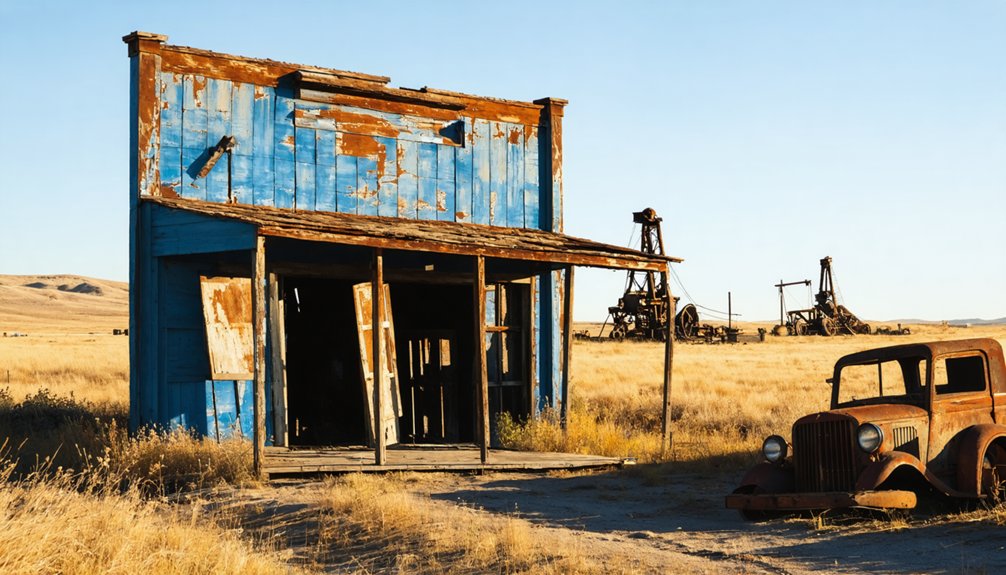
Since its founding in 1908, Coal Springs exemplified the quintessential coal mining community of early 20th-century South Dakota.
You’ll find that mining shaped every aspect of life in this tight-knit community, from employment to cultural traditions. The town’s identity revolved around coal extraction, fostering a unique social fabric that bound residents together through shared experiences and challenges.
Experience Coal Springs’ rich mining heritage through these cultural touchstones:
- Mining festivals that celebrated the town’s economic backbone
- Social gatherings at the post office, which served as a community hub until 1954
- Local customs and traditions shaped by the daily rhythms of mine work
- Community events that brought together miners and their families, strengthening social bonds
Exploring the Ghost Town Today
You’ll find Coal Springs accessible via rural secondary roads in Perkins County, South Dakota, though a 4WD vehicle may be necessary for reaching the site.
While the ghost town retains some visible features typical of abandoned settlements, you’ll need to exercise caution as there’s no maintained infrastructure or visitor facilities on the grounds.
Before exploring the remaining foundations and ruins, you should obtain any necessary permissions since the site may be on private property or managed land.
Current Site Conditions
Today, visitors to Coal Springs will find little more than barren fields where a once-thriving mining town stood.
Years of urban decay and environmental impact have erased nearly all traces of this former settlement, leaving the landscape to return to its natural state.
When exploring the site, you’ll encounter:
- Empty pastureland where buildings once stood, with possible scattered foundation remnants
- No visible remnants of the town’s mining infrastructure or original structures
- An exposed plains environment subject to harsh weather conditions
- Unmarked historic grounds where the school and cemetery were located
The site’s barren condition means you’ll need to rely on historical records and imagination to envision the bustling community that once called this place home.
There are no facilities or marked trails, so careful navigation is essential.
Accessing The Location
Reaching Coal Springs requires careful planning and navigation through South Dakota’s remote terrain.
You’ll find the ghost town at coordinates 45°26′30″N, 102°06′28″W in Perkins County’s unorganized territory. While no major highways lead directly to the site, you can access it via local roads shown on USGS topographic maps of the Coal Springs SE quadrangle.
Since you’ll be traveling through sparsely populated areas with limited local accommodations, it’s essential to prepare thoroughly.
Bring a GPS device, load offline maps, and outfit your vehicle for dirt and gravel roads. Access routes may be unmarked or poorly maintained, so a 4WD vehicle is recommended.
Before setting out, inform others of your plans and pack essential supplies, as emergency services aren’t readily available in this remote location.
Preservation Efforts and Future Legacy
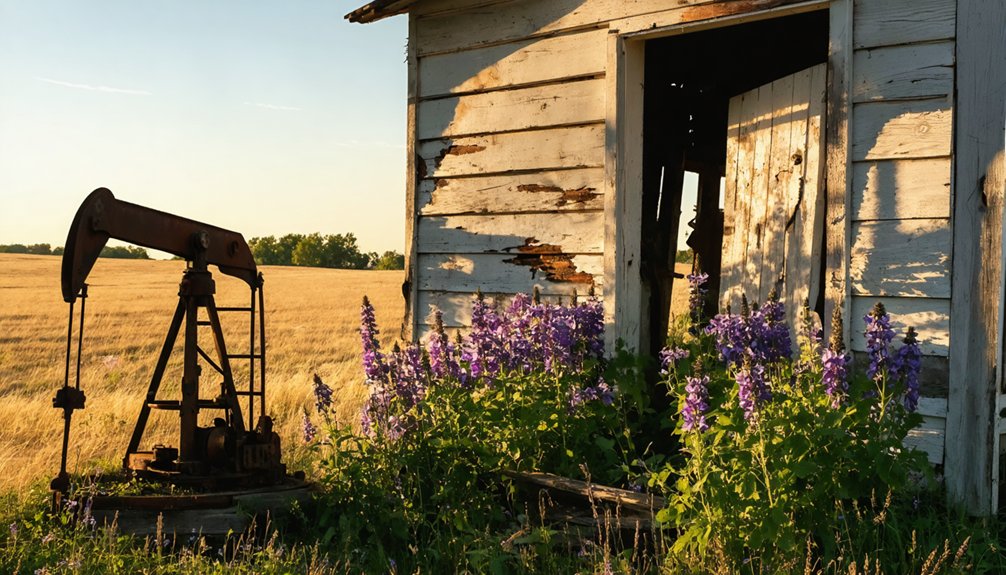
While many South Dakota ghost towns have undergone preservation efforts, Coal Springs remains largely untouched by formal conservation initiatives.
Without community engagement or dedicated preservation strategies, this former mining settlement faces ongoing deterioration from natural elements and time.
You’ll find potential opportunities for preserving Coal Springs’ legacy through:
- Archaeological surveys to document remaining foundations and artifacts
- Development of heritage tourism trails connecting regional ghost towns
- Installation of educational markers explaining the site’s mining history
- Partnership formation with state historical societies and tourism boards
Despite current challenges, Coal Springs holds significance as a symbol of South Dakota’s industrial past.
Its story as a coal mining community from 1908 to 1954 deserves recognition, even though it lacks the visible ruins that attract preservation efforts to other ghost towns.
Frequently Asked Questions
Are There Any Documented Paranormal Activities or Ghost Sightings in Coal Springs?
You won’t find any documented ghostly encounters or spectral sightings in this once-bustling locale. While the town’s spirit has departed, there’s no evidence supporting paranormal activity following its 1954 closure.
What Wildlife Species Now Inhabit the Abandoned Town Site?
You’ll spot mule deer, coyotes, and pronghorn antelope roaming freely through the ruins, while hawks and owls nest in old buildings. Wildlife sightings include rabbits, ground squirrels, and various songbirds.
Is Metal Detecting or Artifact Collecting Allowed in Coal Springs?
Like an eagle’s watchful eye, you’ll need permission first. Current metal detecting regulations and artifact preservation guidelines require proper permits and landowner approval before searching this historically significant site.
What Were the Average Coal Miners’ Wages During Coal Springs’ Peak?
You’d find coal mining wages during this period typically ranged from $1.50 to $2.00 per day, with some miners earning around $0.60 per ton. Historical labor conditions often meant delayed or unstable pay.
Were There Any Notable Accidents or Disasters in Coal Springs’ Mines?
Ever wonder about mining tragedies in small-town operations? You won’t find specific documented accidents for Coal Springs, though the era’s limited safety regulations suggest incidents likely occurred, following regional patterns.
References
- https://kids.kiddle.co/Coal_Springs
- https://www.sdpb.org/rural-life-and-history/2023-08-21/some-black-hills-ghost-towns-and-their-origins
- https://www.youtube.com/watch?v=Glucs_Rq8Xs
- https://www.sdhspress.com/journal/south-dakota-history-2-2/some-black-hills-ghost-towns-and-their-origins/vol-02-no-2-some-black-hills-ghost-towns-and-their-origins.pdf
- https://www.blackhillsbadlands.com/blog/post/old-west-legends-mines-ghost-towns-route-reimagined/
- https://daycountysouthdakotagenweb.github.io/usgenweb-sd-day/lynn.pdf
- https://en.wikipedia.org/wiki/List_of_ghost_towns_in_South_Dakota
- https://www.geotab.com/ghost-towns/
- https://history.sd.gov/docs/Mining.pdf
- https://westernmininghistory.com/towns/south-dakota/deadwood/
